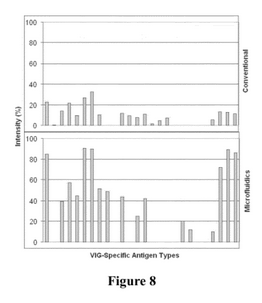Microfluidic device for multiplex diagnostics / Microfluidic devices and methods
Brief Description
Researchers at UC Irvine have invented an antibody-based protein array analysis for quantitative detection of antigens and/or antibodies from crude protein preparations using precipitation or agglomeration dye for visual detection.
Full Description
Detection of antigens and/or antibodies are important for disease diagnostic applications. Current methods for protein detection are labor intensive, require isolated/purified compounds, and are mainly limited to fluorescence or chemiluminometric read out methods. Therefore, an alternative for improved quantitative analysis of antibodies is needed.
Researchers at UC Irvine have invented a microfluidic system for quantitative detection of antigens and/or antibodies from crude protein preparations using precipitating or agglomerating dye. This method involves depositing antigens non-covalently and non-specifically coupled to an optical contrast layer. The antigens are used to capture antibodies present in the serum sample, which does not need to be purified. Further incorporated in this invention are cavities that allow for air pockets, allows for acoustic air bubble resonance mixing of the fluid that is in contact with the optical contrast layer. Addition of the dye into the detection solution allows for formation of a visually detectable spot.

Figure 8 is a graph comparing binding
sensitivity between the contemplated invented microfluidic device hybridization
(bottom) and conventional hybridization (top). Primary vaccinia-immuno-globulin (VIG)
antibody was used against the spotted vaccinia proteome.
Suggested uses
This invention can be used for assays and protein screening.
Advantages
The microfluidic approach offered by this invention eliminates the problem of diffusion-based antibody-antigen binding interactions, and offers shorter reaction times. Furthermore, this invention uses small sample volumes that do not need prior purification.
Patent Status
| Country | Type | Number | Dated | Case |
| United States Of America | Issued Patent | 10,260,168 | 04/16/2019 | 2007-530 |
Contact
- Alvin Viray
- aviray@uci.edu
- tel: View Phone Number.
Inventors
- Felgner, Philip L.
- Lee, Abraham P.
- Liao, Uland
- Tovar, Armando R.
Other Information
Additional Technologies by these Inventors
- New Microwell Plate Configurations to Increase Microwell Density
- Controlled 'One-Cell-One-Bead' Encapsulation in Droplets
- Microfluidic Device for Cell Separation Using Dielectrophoresis and/or Magnetohydrodynamics
- On-Demand Cell Encapsulation Using On-Demand Droplet Generation and Impedance-based Detection
- High throughput and precision cell sorting
- High-throughput Microfluidic Research Platform for Performing Versatile Single-Cell Molecular Timed-Release Assays within Droplets
